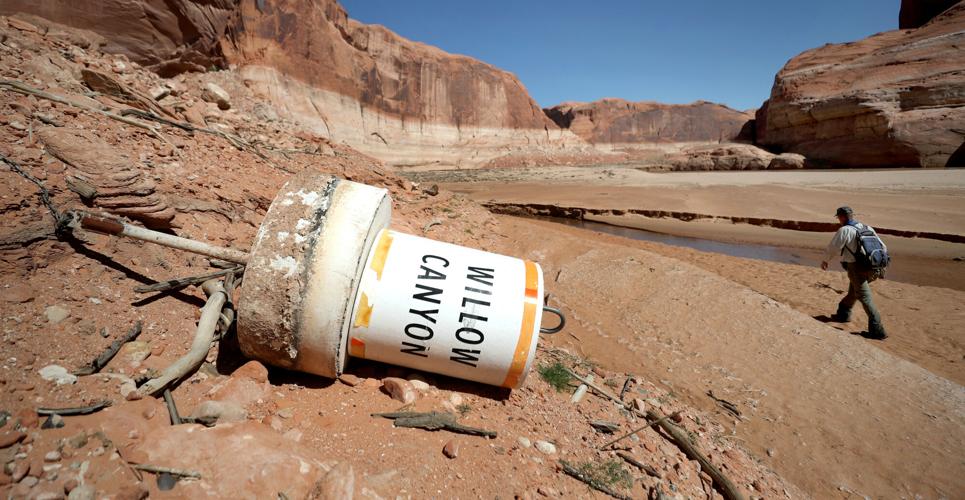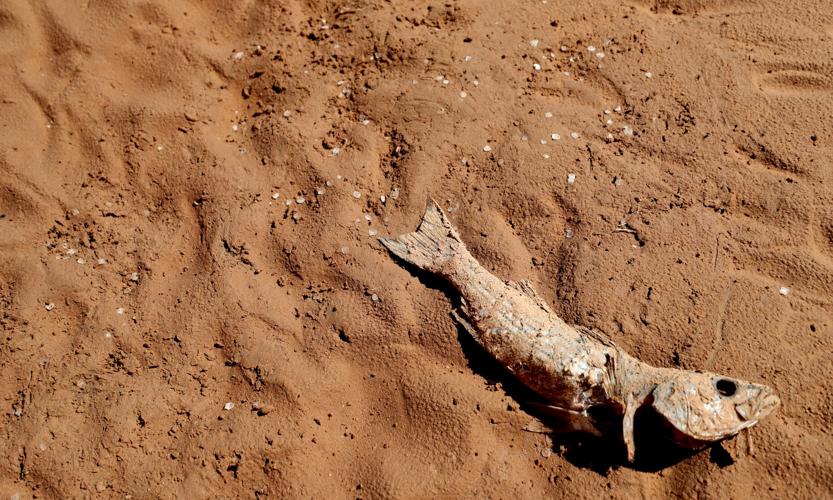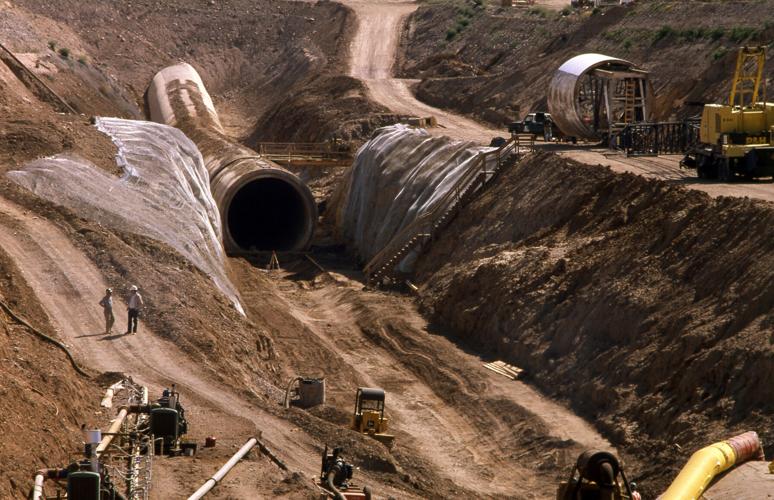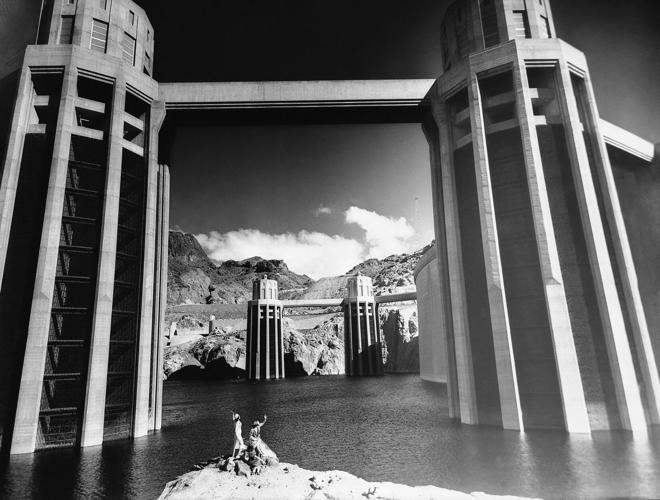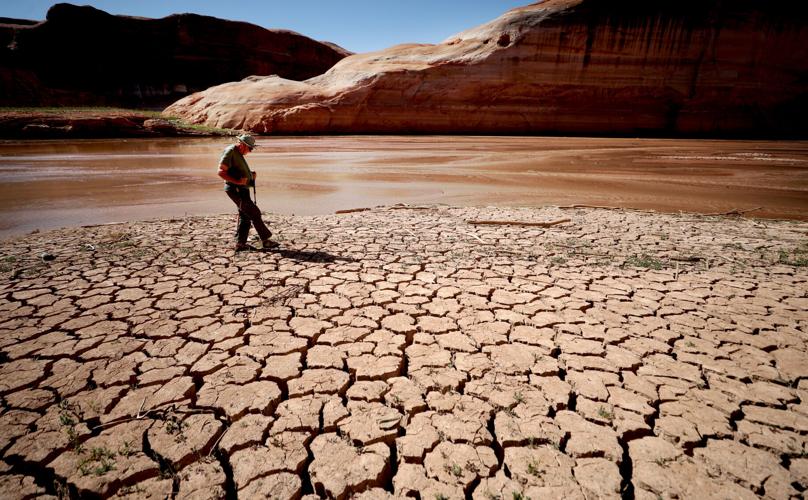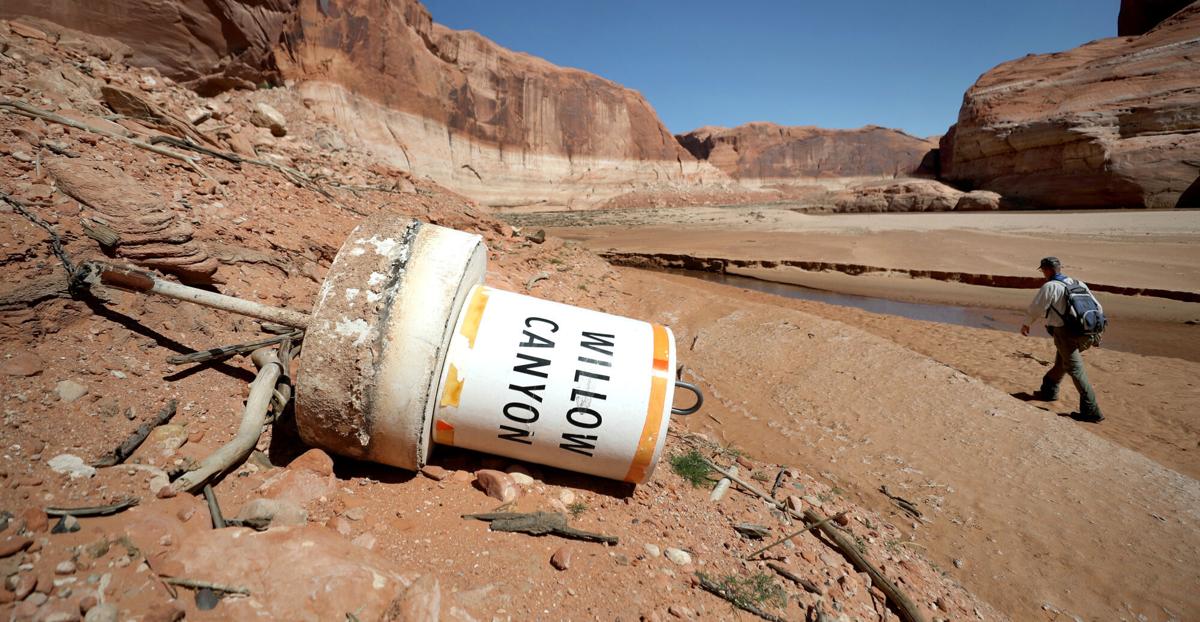Editor's note: This is the first of six stories for "Colorado River reckoning: Not enough water," an investigative series by the Arizona Daily Star that observes, at length, the future of the Colorado River.
The lifeblood of the West, the Colorado River, is slowly dying, its flows that nourish 40 million people in seven states shrinking without respite.
The planet keeps heating up, and the reservoirs that feed the canals bringing water to lettuce and alfalfa fields and to faucets, toilets and lawns keep falling.
The state governments charged with the river's management are locked in a standoff over how to wean themselves from decades-long dependence on this water that borders on addiction. That dependence has been enshrined into the U.S. legal system through treaties, regulations, compacts, court decisions and statutes that collectively add up to the Law of the River.
They can't agree on who should take the biggest cuts, despite pressures to do so from the federal government. Federal officials haven't followed up on their threat to impose a solution, other than to promise some fixes that will arrive in the future.
This web of problems and disputes is symptomatic of a water management system in the early stages of collapse, in the view of Justin Mankin, a Dartmouth University professor who helps lead a federal task force that's monitoring the West's 23-year drought.

Tom Wright of the environmentalist Glen Canyon Institute hikes past the beached marker for Willow Canyon where the water has drastically receded in Glen Canyon National Recreation Area on May 13, 2022.
Such a collapse would mean the laws, rules and governmental structures and policies that underlie this system would no longer be reliable, he said.
Not only would that call into question the system's ability to meet its obligations to deliver water to customers, it would also mean a whole new legal and political structure would have to be developed to govern water allocation and use, he said.
The backdrop to this drama is a century-old system of river water allocations for the states that everyone involved knows is unrealistic but which appears too entrenched to change. The allocations were set by the 1922 Colorado River Compact, which recent investigative reporting has shown was based on assumptions about river flows that some scientists warned even back then were unrealistically high.
A collapse would likely mean the giant reservoirs Lake Powell and Lake Mead would have much less if any water for drinking, bathing and outdoor watering at the homes and businesses from Denver to Tucson to Los Angeles that now rely heavily on river water, Mankin said.
Farmers from Southern California's Imperial Valley to Yuma to Western Colorado who use river water for irrigation would find themselves in similar straits.
Electric power now serving about 5.5 million customers from Glen Canyon Dam and a group of smaller reservoirs in the river's Upper Basin and 8 million from Hoover Dam could also be cut off or severely curtailed.
"The on-the-ground impact is that nobody who uses water at the municipal, household, agricultural or industrial level, can rely on having sufficient water," he said.
The system is too ossified to respond nimbly and quickly enough to a changing climate, he said.

The remains of a big mouth bass lay in the silt just above where the shrunken Escalante River joins Lake Powell. Water from the depleted lakes Powell and Mead serves tens of millions of people in the West, but "there is not enough water as it stands for us to do everything we want," warns Dartmouth professor Justin Mankin.
'Canary in a coal mine?'
For two years, Mankin has served as one of four co-leaders of a drought task force run by the National Oceanic and Atmospheric Administration. Its purpose is to better predict the timing and severity of droughts in the U.S., and to help the federal government insure that water districts, farmers, businesses, and public-resource managers have the information needed to cope with droughts as global warming increases the risks of them.
A geography professor at Dartmouth, Mankin made a point to note that he's a physical climate scientist, not a water policy scholar. His assessment of the Colorado River's problems are his own and are not related to the Drought Task Force, he said.
"Not many scientists are willing to say something like what I'm saying," Mankin said.
But others are also using the word "collapse."
On Aug. 16, Assistant Interior Secretary for Water and Science Tanya Trujillo said Interior is cutting river water deliveries to the three Lower Basin states next year to "avoid a catastrophic collapse of the Colorado River system." Arizona, California and Nevada are the Lower Basin states.
The same day, the Gila River Indian Community said in a news release "that the Colorado River system as a whole is on the brink of collapse."
To tribal officials, collapse would mean reservoirs Mead and Powell reaching "dead pool" levels, at which they could no longer deliver water, an attorney for the Gila community, Jason Hauter, said in an interview. The Gila community is headquartered in Sacaton, about 80 miles north of Tucson off Interstate 10.
As water in one of the nation's largest reservoirs recedes, geologic features hidden for nearly 50 years are revealed in Glen Canyon National Recreation Area in Northern Arizona. Video courtesy of Glen Canyon Institute, 2022
"We are almost out of stored water" in the reservoirs, Hauter said. "We can only exist on what’s in the system. For that to work you have to have a certain amount of water left behind in reservoirs that you can tap into. To do that, there will have to be reduction in use."
Mankin's vision of a systemic collapse runs far deeper than our falling reservoirs.
"The reservoirs, the regulatory framework, the Law of the River — they're not doing what they're designed to do. That sure looks like failure to me. The system is designed to buffer drought and provide certainty and it’s not doing that," he said.
"There are always these competing demands on water out there. Somebody’s going to lose. I don’t think that’s the water economy functioning. The water economy is failing."
He sees Lake Powell's highly uncertain status as a major symptom of the problems with water management across the West, asking if it's "a canary in a coal mine."
Satellite imagery from Google Earth shows Lake Powell from 1984 to 2020. To see how the water body has changed over time, press the play button at the bottom of the image.
Unsustainable
As of now, the lake is not in immediate crisis. It stands nearly 40 feet above 3,490 feet, the level at which it no longer can generate electricity and at which its ability to keep delivering all the water it normally sends downstream to the Grand Canyon and Lake Mead would come under question.
But Powell is artificially propped up in a way that can't last.
The U.S. Bureau of Reclamation sent a half-million acre-feet of extra water downstream this past spring to Powell from the Flaming Gorge Reservoir in northern Utah, after sending about 161,000 acre-feet last year to Powell from Flaming Gorge and other upstream reservoirs. But bureau hydrologic engineer James Prairie told a water conference in Denver in August, "We probably have an opportunity to do it maybe two more times, and then there will be then no more capacity" left for Flaming Gorge releases.
Also, the bureau cut releases from Powell to Mead by almost 500,000 acre-feet in April — an action that if repeated regularly will seriously deplete Mead.
Mead is already falling faster than Powell — 23 feet versus 16 feet since September 2021. It could fall farther still in 2023, because the bureau says it's considering reducing deliveries from Powell to less than the 7 million acre-feet it delivered to Mead this year. That's the least water it's sent to Mead since 1964, when Powell was first filling.
"Is it a mark of a functioning water allocation system to have the two most important reservoirs in the West be unable to perform their basic functions?" Mankin asked. "If you can’t generate power out of Lake Powell or Lake Mead, or if you can’t use Powell as this kind of central bank for water allocations in the same way anymore, and you are having to siphon water from upstream, and you are doing it in unsustainable ways, with no end of drought on the horizon, to me that’s not the sign of a healthy, functioning water economy."
"There is not enough water as it stands for us to do everything we want. If you believe the climate projections, it suggests there is even going to be less to go around going forward. This system is just not built right, this system of power and profit around the allocation of water in the American West. It’s not in a position to be nimble and responsive in the face of an increasing trend to aridity."
He described the collapse as a slow one, taking years, maybe decades.
"If the states of the West are having a hard time managing this drought now, that doesn’t portend sound drought management in the future," he said.

Commerce Secretary Herbert Hoover presides over the signing of the Colorado River Compact in Santa Fe, N.M., on Nov. 24, 1922. Warnings were ignored from the beginning that the brokered deal allocated more water to seven U.S. states than the river could provide.
'A time of unbelievable change'
To get feedback on Mankin's views, the Star reached out to a range of Western water sources, including state and local water agencies, environmentalists, other academics and unaffiliated water experts. Reactions varied, with much of the disagreement centering not on the river's declining flows, but on his tracing the problems to the river's regulatory system.
At the root of that dispute is an ongoing debate over whether the centerpiece of the Law of the River — the 1922 Colorado River Compact — needs to be redone.
Since 2000, the river has carried a bit less than three-fourths of the 16.5 million acre-feet of water a year that the 1922 pact awarded to Arizona and the six other Colorado River Basin states and, later, to Mexico.
An investigative book, "Science Be Damned," found in 2019 that the states and Congress approved the compact despite warnings from a highly qualified scientist that the river wouldn't have enough water to meet its allocations.
Arguments that the compact needs to be revised have been countered by arguments this would usher in endless litigation that would needlessly delay action on the river's problems. This debate is likely to play out more intensely soon, as the federal government leads an effort to revise guidelines it uses to operate the river's reservoirs — guidelines that expire in 2026.
Colorado State University water researcher Brad Udall, long one of the most vocal scientists speaking out on the river's declining flows, said he doesn't disagree with much of what Mankin says, but, "I don't know that I like the word collapse.
"It implies a building comes down and there’s nothing left. That's the wrong metaphor. The word I might use is upheaval. We are in a time of unbelievable change, where everything is being rethought. Events are overtaking basically 100 years of the Law of the River very quickly. We will end up with some new way to operate the system soon," said Udall, a senior water and climate scientist for CSU's Colorado Water Center.
The next few years will be critical for the river in terms of how much flows down it, and how Western water leaders respond to that hydrology, he added.
"it could go from having a system that we're in control of right now to potentially complete chaos. The difference between those outcomes will be the leadership that Colorado River management takes," he said.
"We've still got time to respond. We've got decision makers who deserve a chance to get this right. I’m confident the feds are not going to allow a collapse to occur."
But it's not just the Colorado River that's in trouble in the West, Udall emphasized.
The Rio Grande in New Mexico and Texas, the Klamath River in California and Oregon, and the entire Sacramento-San Joaquin river system in northern California also are seeing reduced flows, in part because of climate change and in part due to overuse, said Udall, who a decade ago was director and principal investigator for NOAA's Western Water Assessment program.
"It's important we understand the breadth of and the nature of the problem and the causes," Udall said.

An irrigator works at fixing a clogged sprinkler in a freshly planted winter vegetable field in the Yuma Valley. Farms in the seven Colorado River basin states use an estimated 70% to 80% of the Colorado River's water, so they will be the biggest targets for cuts.
'I don't see how this ends well'
Symptoms of a possible collapse, as Mankin sees it, come through clearly in the dramatic, recent change in the writings of New Mexico author-researcher John Fleck, a co-author of "Science Be Damned."
Long a guarded optimist about the river's future, Fleck took a deeply pessimistic tone in his "Inkstain" blog in late September, warning it's hard not to see "dead pool looming." The reservoirs will hit "dead pool" at levels so low that water can no longer be extracted from them.
In his 2016 book "Water is for Fighting Over," however, Fleck wrote that even with climate change reducing its flows, he saw hope that the river could survive relatively intact.
For one, he recalled a series of water deals made among various parties showing their willingness to collaborate, most notably in a 2003 agreement in which Southern California users gave up the nearly 20% of their total take from the river because that exceeded the amount they have legal rights to. Second, he observed that "when people have less water, they use less water," noting that cities and towns across the West have repeatedly managed to conserve as the supply dwindles.
But today, while still believing shrinking water supplies can be conserved without significant damage to local economies or communities, he's frustrated that the basin states seem unwilling to do that.
"Climate change and drought have outpaced in the last several years the capacity of those tools to deal with our problems," he said in an interview, speaking of collaboration and conservation. "What I did not understand is how hard it would be to scale that up in a hurry."
Fleck started and finished his Sept. 27 blog post on the river's crisis with the phrase, "I don't see how this ends well."
'Five-alarm fire bad'
Fleck's post portrays the key players in ongoing water conflicts — Arizona, California and the federal government — as "boxed in" from taking action by various political and legal constraints, "while the water in the Colorado River’s big reservoirs is circling the drains."
Arizona, having given up 800,000 acre-feet of river water this year, is unlikely to give up more without substantial cuts from California, he wrote.
In California, officials have offered to cut their total river water use by 400,000 acre-feet, less than one-tenth of the state's total legal supply. But that cut won't be nearly enough for the Lower Basin to meet its share of the 2 million to 4 million acre-foot cut that federal officials are demanding of all seven river basin states. It would almost certainly require Arizona to put up far more than it's been willing to do to date, potentially precipitating a political and legal deadlock.
Fleck also ran through the latest negative Bureau of Reclamation forecasts for reservoir levels for the next two years. For Powell, the "minimum probable" forecast for the next two years shows it falling below the level at which Glen Canyon Dam can produce electricity starting in December 2023, and staying there for seven of the next eight months.
For Lake Mead, the "minimum probable" forecast shows it falling below 1,020 feet, compared to about 1,044 feet today, for every month from September 2023 through August 2024, and below 1,000 feet for the last three months of that period.
While those levels are well above 950 feet, below which Hoover Dam can't generate power, they're well below 1,025 feet, the level at which the most severe cuts to Lower Basin water users would occur under the 2019 Drought Contingency Plan.
"For those not steeped in the numbers, this is cracked-mud, five-alarm fire bad," wrote Fleck.
His post saw federal officials as "frankly boxed in" by the paralysis that always accompanies a looming election, by the Lower Basin states' unwillingness or inability to cut enough water use, and by the need to better include tribes in their discussions, among other forces.
"It’s hard to look at all these constraints, the boxed-in-ness — on Arizona, on California, on the federal government — and not see dead pool looming," Fleck wrote.
Since Fleck's post was published, a new Bureau of Reclamation action has given the researcher more optimism that something might be done in the coming year to stabilize the river's battered reservoirs. In late October, the bureau announced plans to approve a blueprint by August 2023 to reduce water use in the entire river basin.
One alternative it will consider is imposing its own solution, as it has threatened to do since mid-June. A second alternative would be for the bureau and the states to work out a solution collaboratively. While either solution would delay water use reductions until early 2024, the bureau also is raising the possibility it could cut water releases from both Mead and Powell much sooner if needed.
But Fleck told the Star he generally doesn't disagree with Mankin's view the system is on the edge of collapse.
"Clearly the system is failing us, meaning the interactions of physical infrastructure and water allocation rules," Fleck said.
Since Interior Department officials warned in June of the need to cut up to 4 million acre-feet a year of river water use, in particular, the system "has failed a really important test," he said.
"What you see right now is a whole bunch of people making the argument about what they’ve already given up and 'the responsibility for the next actions must fall to others'," Fleck said. "There’s not enough water for all of us to be right."

Central Arizona Project construction in Western Arizona, 1979. The $4 billion canal system delivers drinking water from the Colorado River to Phoenix and Tucson and irrigation water for farms. Tucsonans currently drink only CAP water, but the project faces continuing cuts due to drought and climate change.
Cycles of 'crisis and neglect'
The reservoirs whose water is “circling the drains” have been essential in making the American West habitable, Mankin noted.
“The structures that we built on the Western landscape are gigantic, massive interventions in local hydrology. These reservoirs have been essential for providing water to do a whole host of things, from growing food to recreating to generating power. They are designed to do so when there isn’t enough water to fall from the sky. We made these massive interventions to assure water supplies in times of drought,” he said.
So far, he thinks they’ve done “OK” and that one could argue they’ve managed to operate well during the last 20 years of “megadrought.” But he added: they’ve never really flourished.
“This latest drought has kind of revealed how vulnerable this system is, how the water economy of the West has been operating at an incredibly thin margin for decades,” he said. “For awhile, the margins were favorable. But this drought has kind of shown that this water system in the American West is not well adapted to climate change."
Mankin's larger point is that the strategies officials have pursued so far — drawing emergency water from upstream or cutting deliveries to downstream users — “just kick the can down the road and deepens our vulnerability."
Probably his biggest concern is that the states and federal government continue managing the river and its reservoirs through various cycles of “crisis and neglect.”
“A crisis is something you manage over the short term to get back to normal, and so the response is really centered around returning to normal. The focus on returning to normal often obscures the structural processes that led to the crisis to begin with,” Mankin said. “Focusing on drought as a crisis obscures any meaningful evaluation.”
For one, he cited the $2 million, two-year study the Bureau of Reclamation launched in early 2022 to investigate ways to continue producing electricity at Glen Canyon Dam if Powell drops below 3,490 feet.
“The idea of investing a whole bunch of money to continue to produce hydropower from Glen Canyon Dam, maybe it is a strategy to pursue, but it’s not clear that strategy is borne of clear-eyed, holistic long-range planning to insure that you get the greatest bang for your buck,” he said. “It’s entirely within the realm of possibility that Reclamation could go through this arduous process of lowering the water level where power could be generated, and in a few years time, we’ll be right back where we are now. I don’t think anybody would be surprised."
The question of how to keep providing power from the two dams for the long term is one the states and Reclamation have yet to really contend with, he said.
"That leaves a lot of people who rely on that power in limbo," he said. "The more the strategy is to hold onto the status quo rather than being clear-eyed about sustainably sourcing energy for people, given the current hydroclimate in the West, the more that is creating uncertainty."
Today, as the basin states and federal government struggle to find ways to immediately cut their water use, Mankin said it’s positive to see “the right people are alarmed,” but he doesn’t think the crisis has reached a point leading to restructuring how water is allocated.
"A cut in water use doesn’t fix structural issues. A cut is a short-term solution.”

Boulder Dam's mighty water intake towers are shown in this picture of the gigantic electric power project from 1938, as Lake Mead was filling. Today that power serves 8 million customers in the West. But federal forecasters say Lake Mead's water level could drop so low in a few years it couldn't generate power.
Some say the river compact isn't the problem
Asked how he would fix the West’s structural water problems, Mankin replied, “The short answer is, I do not know.”
But he doesn’t see the current system tied to the 1922 compact as sustainable.
"What is the value of a regulatory framework that assumes a climate we no longer have? I’m not a lawyer but that strikes me as a fallacious premise for a legal framework that is so crucial to well-being in the West."
"I think that the extent to which the Law of the River is grounded in an annual allocation of seven million acre-feet a year of water to the Upper and Lower basins, then that is not really tenable, is it?"
But the compact and other elements of the Law of the River have long been the glue that many water leaders believe has held the river system together through a century of water surpluses and shortages, and of court fights and congressional conflicts.
That point was driven home last month, in a letter to the Bureau of Reclamation from the seven river basin states' top water officials. They argued the Law of the River "must be the foundation" for how new rules for operating reservoirs are written.
Besides the 1922 Compact, the Law of the River also includes a 1948 compact governing the four Upper Basin states and a 1944 treaty awarding Mexico 1.5 million acre-feet a year of river water, the states said.
"The new operating rules should not interfere with the right of any state to administer and regulate water within its boundaries in relation to the appropriation, use, and control of water. The existing framework provides legal certainty regarding management of the Colorado River System and its infrastructure. It also allows for collaboration and consensus which helps avoid the uncertain outcomes that result from litigation," said the letter, whose signers include Arizona Department of Water Resources Director Tom Buschatzke.
The letter acknowledged that the last 20 years of drought and increasing aridity on the river have highlighted the system's vulnerabilities that the new rules should address. To improve operations at Lake Powell and Lake Mead, the new operating rules should address risks and opportunities resulting from increased variability in river flows, including climate change impacts, and produce mechanisms to restore the depleted reservoirs, the letter said.
Instead of calling for structural change in river management, the Sept. 1 letter from the states said balancing water use and river depletions with available supply "is the foundation for sustainable management under Post-2026 operations. This should include the advancement of meaningful water conservation programs across all sectors and transparent and accurate accounting of depletions and available supply."
Asked separately to comment on whether the river system is on the verge of collapse, ADWR and the Southern Nevada Water Authority declined.
In an email to the Star, Adel Hagekhalil, general manager of Southern California's Metropolitan Water District, also didn't respond to that question, but said the Colorado River Compact isn't the problem — it's drought, climate change, and the resulting declines in runoff and reservoir levels.
"The challenges before us are significant. We must immediately respond to the dropping levels of Lake Mead and Lake Powell, while at the same time seeking ways to bring longer-term balance to the river through post-2026 operations. These unprecedented conditions caused by climate change require unprecedented and bold actions anchored in integration, innovation and inclusion," Hagekhalil wrote.
"The good news is, we have the legal foundation on which to build short- and long-term solutions. We are not starting from scratch. The Colorado River Compact provides both legal certainty and the flexibility needed to adapt to our changing future," said Hagekhalil, adding that tackling drought and related issues "is tough enough, without adding unnecessary litigation and uncertainty."
We'll all have to live with less, permanently
Everyone who relies on Colorado River water, including Southern California, is going to have to live with less, permanently, Hagekhalil said.
Other river basin water users recognize that, and that's why the various states signed off on a drought contingency plan in 2019 and a less sweeping "500-plus" plan last year to make additional cuts in Lower Basin water use, he said. That's also why Nevada and Arizona have invested in Metropolitan's plans to develop one of the world's largest water recycling facilities, he said.
"And it is why we will continue our work at the negotiating table to find immediate and long-term solutions.”
But Eric Kuhn, a Colorado researcher, author and former water district general manager, predicted at a recent water conference in Colorado that river flows are now dropping so fast that in a few years, rather than renegotiate or amend the compact, "we will ignore all provisions" except for its first article, which simply lays out its purposes.
"So many fundamental changes are needed, and time is so short, we don’t have time to rethink the Law of the River," said Kuhn, who co-authored "Science Be Damned."
The compact's allocations of 16.5 million acre-feet a year don't work with a river that has carried barely 12 million since 2000 and about 10.5 million since 2018, he said. Even more pessimistic forecasts of 9 million a year have very low probabilities but aren't totally unrealistic, he said.
Flows that low "would force major, major changes in how we do business," Kuhn said in an interview. "We're already in an era of doing things very differently than we thought we were at a few years ago."
'You are taking peoples' property rights'
Jennifer Gimbel, a water expert at Colorado State, strongly disagrees with Mankin's arguments, particularly his view that the Colorado River Compact needs overhauling. Gimbel is a senior water policy scholar at CSU's Colorado Water Center. She's also a former official of the Bureau of Reclamation and the broader Interior Department, and a former Colorado governor's representative in Colorado River water negotiations.
Gimbel defends the water rights system encouraged by the compact that's known as prior appropriation, in which those with earlier water rights have higher priority to river water than those who got their rights later. In the Lower Basin, the earliest rights are held by tribes and numerous non-Indian farming districts, while the Central Arizona Project's rights are among the very latest, dating to Congress' approval of CAP in 1968.
"The West was populated under the prior appropriations system and many states’ constitutions provide for the prior appropriation system. It’s a pretty solid method of administering water rights," one based on the theory that water rights are property rights, she said.
Gimbel also disputes Mankin's view questioning the value of our legal water management framework.

Environmental activist Frank Colver makes his way over the dried and cracking silt left where the Escalante River joins Lake Powell in Glen Canyon National Recreation Area, Utah, on May 13, 2022. The receding water of the lake has the river cutting through the decades of accumulated silt to form a delta where it meets the lake.
"What else is there if you change that framework and you change water law? You are taking peoples’ property rights and you'll have to pay for it.
"If you completely change it, what do you change it to? We are very oriented on states' rights. The only way you could change it is to a federal system for managing water. I just don’t see that happening."
"We all know they divvied up the river with more water at the time than there is now," Gimbel said. "Fixing that goes back to demand management. How can we operate the river so everyone is sharing the risk of aridification, yet continue to grow our robust economy to feed people and give them water for health and welfare?"
Unlike Mankin, Gimbel sees the reservoir system as still functional, while acknowledging it’s been under a lot of stress.
“He acknowledges the reservoirs were built to capture water in the good years to sustain us in the bad years. They’ve done that. We’ve maintained our economy for the last 20 years on the Colorado River. There’s obviously issues now with the Colorado River, but the reservoirs in general, they are doing what they are supposed to do.
“I don’t agree that the system is on the edge. The hard part is when you have the two largest reservoirs in the country on one river system, the way they been operated over the last 20 years, maintaining overuse of water by the Lower Basin, that is where we’re hurting,” Gimbel said.
To her, fixing things is a matter of experimenting and trying alternative management strategies. The seven states have done that twice now — first when they approved operating guidelines for the reservoirs in 2007, second when they approved separate drought contingency plans for each basin in 2019. Neither has worked as well as officials had hoped, “considering the climate we have,” she said.
Today, “I feel a lot more optimistic than Professor Mankin,” she said. “He acknowledges there’s a lot of very smart people working on this. These people have shown themselves to be capable of thinking outside the box.
“They are innovative. They are creative. They all have constituencies they have to report to. One of their challenges is just getting the political will in each of the seven basin states to try something different, as well as getting the federal government to agree to do something different."
'Yes, we're in the early stages of collapse'
Much less optimistic is Kathleen Ferris, director and chief counsel for the Arizona Department of Resources nearly four decades ago and today a water lawyer, policy analyst and researcher.
“I’ve never seen a situation where every single person in water I know is equally concerned. Many times in the past, people would say 'we can make it through this and through that. We just need a few good years. We just need to work a little harder.' No one is saying that anymore. Anyone who is responsible is saying we’ve got a real big problem here,” Ferris said.
“Yes, we’re in the early stages of collapse. I’m seeing the headlines, and the fear among the people who should know the most about this, the water managers. They're not so sure we can get through this when they used to say we could,” said Ferris, a senior research fellow at Arizona State University’s Kyl Center for Water Policy and a legal counsel and policy adviser for the Phoenix-based Arizona Municipal Water Utilities Association.
Part of the reason it’s been hard for the basin states to reach consensus on cutting water use is that it’s not clear people have a good understanding of what the options are, Ferris said.
If Mankin says "this 100-year-old system doesn’t conform with reality, what does?" she asked. "Is it replumbing the reservoirs? Is it taking down Glen Canyon Dam? And I’m not hearing the government talking much about what might be done.
“I hear them saying, 'We’re going to try to figure out a way to get water out of Lake Powell below dead pool.' That’s just creating another problem to me. How long can that last? That is a short-term fix for a long-term problem. Because if it reaches dead pool, and you take the water out that's still there, there’s nothing there left,” Ferris said.
“I would like to be optimistic about the future of the Colorado River. Right now, I don’t see anything out there to give me optimism."
"We have to change the way we live," she said. "Our priorities have to change. We have to really think hard about growth and how we’re going to get from here to there. We have to live within our means, but first we've got to figure out what our means are and go about living within those means."
Longtime Arizona Daily Star reporter Tony Davis shares how he came to focus on coverage of the Colorado River as an environmental reporter.
Photos: The receding waters of Lake Powell, Glen Canyon National Recreation Area

Tom Wright hikes past the beached marker for Willow Canyon where it joins with the Escalante River, Glen Canyon National Recreation Area, Utah.

A big horn sheep stands with the moon as a backdrop, looking over Fiftymile Creek, Glen Canyon National Recreation Area, Utah.

Tom Wright walks through the shaft of light peeking through the narrow openings of the formation called the Subway in Fiftymile Creek, accessible since the waters of Lake Powell have fallen dramatically.

A narrow sliver of sky is visible overhead through the narrow opening of the formation called the Subway, Fiftymile Creek, accessible since the waters of Lake Powell have fallen dramatically.

The dark streaking, called Desert Varnish, is from the seepage of oxidation in the rocks, and is beginning to erase the "bathtub ring", the lighter colored marks left by the waters of Lake Powell on canyon walls, Fiftymile Creek, Glen Canyon National Recreation Area, Utah.

The remains of a small boat, underwater for years, reemerges due to receding water levels of Lake Powell in the Glen Canyon National Recreation Area, Utah.
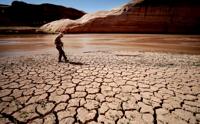
Frank Colver makes his way over the dried and cracking silt left where the Escalante River joins Lake Powell, Glen Canyon National Recreation Area, Utah. The receding water of the lake has the river cutting through the decades of accumulated silt to form a delta where it meets the lake.

A warning buoy sits high and dry far from the end of the closed public boat ramp at Bullfrog Bay, Glen Canyon National Recreation Area.

A line of tires that were once breakwaters at Bullfrog Bay Marina are now stranded on the rocky landscape high above the current water levels at the Glen Canyon National Recreation Area, Utah.

A pedestrian ramp lies well above the water levels at Bullfrog Bay in the Glen Canyon National Recreation Area, Utah.

A stranded wakeless zone buoy sits on the cracking silt outside the new shores of the Bullfrog Bay Marina, Glen Canyon National Recreation Area, Utah.

The end of the ferry ramp ends well short of the new water levels of Bullfrog Bay on the Glen Canyon National Recreation Area, Utah.

An early riser watches the sun come over the low waters of Bullfrog Bay Marina, Glen Canyon National Recreation Aria, Utah. The lighter colored areas on the canyon wall mark previous water levels.

A group of river rafters drift west on the current of the San Juan River outside Mexican Hat. The San Juan feeds Lake Powell.

The tops of a few cottonwood trees begin to poke out of shrunken water of Lake Powell, Fiftymile Creek, Glen Canyon National Recreation Area, Utah.

The remaining large water craft and house boats are crowded together in one of the last areas of water deep enough to support them at Wahweap Mariana, Glen Canyon National Recreation Area, Page, Ariz.

The waters of Lake Powell are twenty to thirty feet below the end of the public boat ramp at Wahweap Mariana, Glen Canyon National Recreation Area, Page, Ariz. Personal non-powered craft still use the ramp to unload, but must be carried up and down the banks to reach the water.
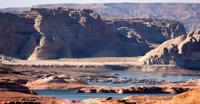
A view north from the Wahweap Marina Overlook show the shrunken waters around the marina in Glen Canyon National Recreation Area, Page, Ariz.

The underside of Gregory Natural Bridge, passable for the first time in almost 50 years, over the Fiftymile Creek, Glen Canyon National Recreation Area, Utah.

The moon rises over Gregory Natural Bridge, passable for the first time in almost 50 years, over the Fiftymile Creek, Glen Canyon National Recreation Area, Utah.

The exposed penstocks (intakes to the power turbines) on Glen Canyon Dam in the Glen Canyon National Recreation Area, Page, Ariz. The water level is at its lowest since 1967, when the dam was still being initially filled.

A group of sightseers get a look at the Glen Canyon Dam during a boat tour of Lake Powell, Glen Canyon National Recreation Area, Page, Ariz.

A small fishing boat ties up on the breakwater just outside the intakes for the Glen Canyon Dam, Glen Canyon National Recreation Area, Page, Ariz.. The penstocks (water intakes to the power turbines) are revealed for the first time since 1967 when the Lake Powell was being filled.

Swimmers and bathers use the jagged shores of the newly exposed banks of Lake Powell just above the Glen Canyon Dam, Glen Canyon National Recreation Area, Page, Ariz.

The Glen Canyon Bridge lies in front of electrical towers with feeder lines rising from the hydroelectric plant in the Glen Canyon Dam, Page, Ariz.

Glen Canyon Dam from Glen Canyon Bridge, Page, Ariz.

Small power boats on the Colorado River head upstream just below the Glen Canyon Dam, Page, Ariz.

Wade Quilter walks through the remains of cottonwood and Russian olive trees washed down and joined with silt to form a natural dam where Willow Canyon joins with the Escalante River, Glen Canyon National Recreation Area, Utah,

The remains of a big mouth bass lay in the silt just above where the Escalante River joins Lake Powell, Glen Canyon National Recreation Area, Utah.

The formation known as The Cathedral in the Desert on Clear Creek, Glen Canyon National Recreation Area, Utah. The re-emergence of the formation is drawing sightseers after being submerged for some 50 years.
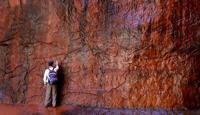
Tom Wright feels the water oozing from the rocks in the formation known as Cathedral in the Desert on Clear Creek, Glen Canyon National Recreation Area, Utah. The re-emergence of the formation is drawing sightseers after being submerged for some 50 years.

Frank Colver takes a quiet moment and plays a handmade flute near the waterfall in the formation known as Cathedral in the Desert on Clear Creek, Glen Canyon National Recreation Area, Utah. The re-emergence of the formation is drawing sightseers after being submerged for some 50 years.

Jake Quilter walks down the newly cut banks of Clear Creek just outside Cathedral in the Desert, Glen Canyon National Recreation Area Utah. The sand is silt left behind by the receding waters of Lake Powell.

The tops of cottonwood trees that used to be under a hundred feet of water in Lake Powell are visible again in Clear Creek, Glen Canyon National Recreation Area, Utah. The deep water preserved the remains of the trees.

Boaters have to zig-zag through the rocks emerging due to receding waters of Lake Powell, Glen Canyon National Recreation Area, Page, Ariz.

Several images combined for a panoramic view of the Colorado River where it runs through the what once was Hite Marina in the Glen Canyon National Recreation Area, Utah.

A couple of sightseers take in the view from Hite Overlook over the Colorado River and the closed Hite Marina, Glen Canyon National Recreation Area, Utah.
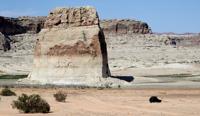
Lone Rock, jutting out of the dry bed, would usually be surrounded by Lake Powell but is now well clear of the water, Glen Canyon National Recreation Area, Utah.

Tires that used to hold the lines well below the surface of Lake Powell are suspended over the water at Antelope Point Marina, Ariz.
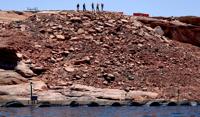
Sightseers twenty or thirty feet above get photos of the low water levels of Lake Powell from the public boat ramp at Antelope Point Marina, Ariz.

The pedestrian access ramp ends abruptly twenty feet over the new Lake Powell surface at Antelope Point Marina, Ariz.

The entrance to the pedestrian access ramp of the Antelope Point Marina is taped off after being cutoff from the docks due to receding waters of Lake Powell.


